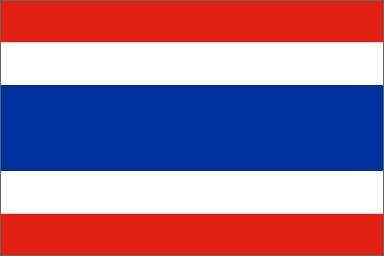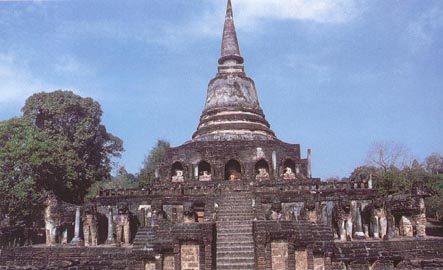|
|
|
 The
Thai's Golden Age
The
Thai's Golden Age 
The golden age of the Thai kingdom of Siam, which was also the heyday of Thai art, lasted from the 13th to the 15th century. Earlier than this, and during a brief overlapping period, from the 7th to 14th centuries, east, northeast, and central Thailand were influenced by the art of the mighty Khmer, whose irresistible artistic dominance began with the reign of Suryavarman I (1002-1050).
The so-called Lopburi style - named after a city in central Thailand conquered by the Khmer - was succeeded by the Chiang Mai style, which marks the beginning of an independent Thai art. An important element in the development of this independence was the fact that the Thai and Khmer had completely different notion of kingship: for the Khmer, the king was a god, and he was honored accordingly. The Sukhothay (Sanskrit: Sukhodaya, "source of happiness") rulers, on the other hand, were close to the people, and all the subjects took part in the religious feasts and rituals that in the Khmer kingdoms were reserved for a small elite. This greater degree of social unity in Thai society is clearly reflected in their arts: it is precisely a skillful and harmonious blending different artistic elements and influences (primarily Khmer architecture and the art of theMon) and the subsequent creation of a new canon of architectural and sculptural forms that characterize the art of the golden age in Thai culture.
| The religious
heart of the kingdom was undoubtedly the Wat Mahathat in
Sukhothay, a temple complex surrounded by an artificial
water - course and a wall - an allegory of the cosmic
ocean and the boundary wall of the universe. The temple
for the relics of the Buddha (a hair and a bone from the
neck), which according to tradition came from Ceylon (Sri
Lanka), was completed in 1345 by King Lo Thai. Adorned with nine
towers and crowned by the unique Lotus Chedi,
this sacred complex expresses the political superiority
of Sukhothay by means of an elegance and refinement that
draws on several artistic traditions. The central tower
is surrounded by four smaller chedis in the Srivijaya (Sumatra) style, alternating with
the four Khmer prangs. Remains of the original stucco decoration, as well as a few reliefs depicting monks, are still preserved on the prangs. The inner peak of the wat is an allegory of the mythical Mount Meru, which stands at the center of the universe. Some original statues of seated Buddhas are still to be found between the ruins, as well as two monumental seated statues of the "forgiving Buddha." Their apparently accidental presence, together with the sublime and at the same time almost weary delicacy of their bearing, lend a mythical charm to the complex. This statue is one of the few works of art preserved from the period when the temple was built. The Wat Mahathat (means "a relic of Buddha") is the most important shrine for relics, and is situated at the very center of the rectangular city of Sukhothay. As a stone plaque dating from the period when the temple was constructed makes clear, the nine towers on the raised platform are symbols of Mount Meru (here called Kailasa) and its environs, home of the Hindu god Shiva. |
 Wat Mahathat - Completed 1345, Buddha statue in the ruins of the temple complex, Sukhothay, Thailand.
Wat Mahathat - completed 1345,Sukhothai, Thailand. |
 Wat Chang Lom - 14th century, temple complex, Sri Saccanalay, Thailand. |
The twin city
of Sukhothay, Sri Saccanalay, became the seat of the
king's son during the fourth regency period of the
kingdom. Probably built in the grounds of the former
Khmer city Chaliang, Sri Saccanalay is also thickly
dotted with monuments. The capitals Ceylonese-inspired chedi
Chang Lom is the first example of a new style and the
model for many later buildings. On the lowest step of the
building are the remains of 39 elephant caryatids,
separated by columns that served as lantern supports. In Sanskrit sri sajjanalaya means "residence of the true man". |
In time the "golden kingdom" of Sukhothay was eclipsed by the kingdom of Ayuthaya, which appeared in the central plain of Thailand about 50 kilometers (30 miles) from present-day Bangkok- In the course of the succeeding centuries, the cities of Sukhothay and Sri Saccanalay gradually succumbed to the all-embracing jungle.
Only in recent times have these historic sites begun to be secured and restored. Today they are part of the world cultural heritage program, and so are protected by UNESCO.